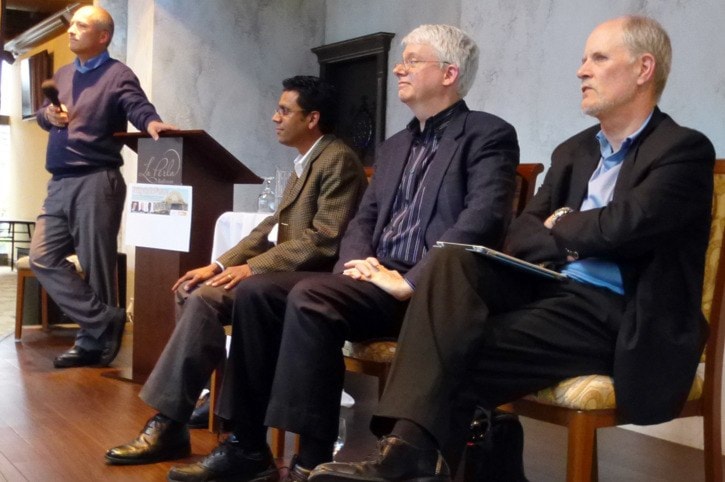It was touted as a chance to explore what could be done with the old Pattullo Bridge once a new bridge was completed.
The event, held Wednesday night at New Westminster's River Market, was organized by local residents Keith Mackenzie and Daniel Fontaine, who hoped to discuss visionary ideas such as a bridge re-purposed for restaurants and cafés, a linear park, or even housing—judging by the preview posts on the event's Facebook page.
Instead, the event was immediately gripped by what are perhaps the more pressing questions of how will the Pattullo be replaced, where, and should it be scrapped altogether.
TransLink wants to build a new, six-lane bridge near the old span's current location by 2018. New Westminster residents have voiced strong concerns about the impact this larger bridge could have on livability, while the City of Surrey is clear that a six-lane bridge is needed.
At Wednesday's event, Gordon Price, director of The City Program at SFU compared the current situation to the opening of the original, five-lane Port Mann Bridge in 1964, which paved the way for rapid development in the Fraser Valley. This bridge created communities that were car-dependent, he said.
"I'm not going to beat up on the car or the truck—they are absolutely indispensable," said Price. "It's the dependent part that is the problem."
Price and fellow speaker Anthony Perl, an SFU professor, said the current discussion about the bridge should look to the future, and the changes in energy prices and people's habits that are already underway. It would be unfair to criticize the decision makers in 1964 who decided to build the original Port Mann, Price said, but "are we going to lock the next generation into further car dependence, by not looking at other options?
"To do that today in 2012 is breathtaking."
Both men talked about how the number of vehicles on the road, per capita, is actually decreasing, and how many young people are opting not to purchase a car at all.
New Westminster transportation engineer Jerry Behl reiterated the city's concerns that TransLink has presented only one option—a six-lane replacement—and that the city wants a broader range of options put to the public, including a four-lane bridge, a rehabilitated three-lane, decommissioning it altogether, or moving it to link Surrey to Coquitlam.
"It seems we're doing all the right things," Behl said, in reference to creating a dense urban city well-served by transit. "But we've still got issues with through traffic and truck volumes."
Price, a former councillor in the City of Vancouver, made a prescription for what he believes should happen. First, TransLink's 2008 vote to only consider a six-lane Pattullo Bridge replacement must be revisited. Next, New Westminster has to "get serious" about its stated goal to have "no new net capacity for through traffic." The great turning point in the City of Vancouver's history, he said, occurred in about 1972 when the city council of the time said they would add no more capacity for single-family vehicles in the city's core—no more roads or bridges. Today, this is one reason Vancouver is cited as one of the world's most livable cities.
"You can make a judgment about whether the council was right or wrong," said Price.
But he also pointed out that New Westminster can't simply say it doesn't want the traffic and insist another municipality take on the burden.
"You'll have the moral high ground, but you're going to lose."
There has to be some give and take, he said.
"If you don't spend that money to build that bridge, what do you use it for?" Price said, suggesting it could go for transit south of the Fraser, like light rail for Surrey.
Among the 80 or so people in attendance was Surrey City Coun. Barinder Rasode, who said her city is working to build a denser, more transit-oriented city, but it's growing so fast.
"Right now we're in a position where a lot of people commute for work," Rasode said, adding a reference to discussion among the New West-heavy crowd who talked about how nice it was when the Pattullo was shut for eight days in 2009 due to a fire.
"The story was very different in Surrey," Rasode said. "Is a six-lane bridge the way to go? I'm not convinced it's not, given out situation on the other side."
TransLink "politely declined" a request to provide a speaker at the event, Fontaine said.
During the question period, Price got no response when he asked whether there was anyone from the trucking industry, Port Vancouver or the Gateway Council in attendance. He then suggested that these people don't have to attend a forum like this, because they're already the ones driving transportation policy in B.C.—not the people stuck in traffic.
The panelists and several people in the audience questioned how easily governments spend huge sums on roads and bridges—$3 billion in the case of the Port Mann Bridge/Highway 1 project—and very little in transit.
Yet there seems much more appetite for transit, judging by the fact the recently opened Golden Ears Bridge has seen fewer cars than projected, while ridership on the SkyTrain's Canada Line has far exceeded expectations.
Perl attributes this to the fact TransLink planners based their projections upon oil at $60/barrel whereas today it sits near $85.
Price also bemoaned the mindset that he says shortchanges transit—citing the second audit of TransLink as an example.
"Why are we cutting it off at the knees? And yet we seem happy to overspend on unused bridges."
If there's a theme to this debate, Price said, it's one of a generational shift in attitudes underway about how we move.
"That's why the Pattullo is one of those markers; it will tell us about who we are and where we're going."
